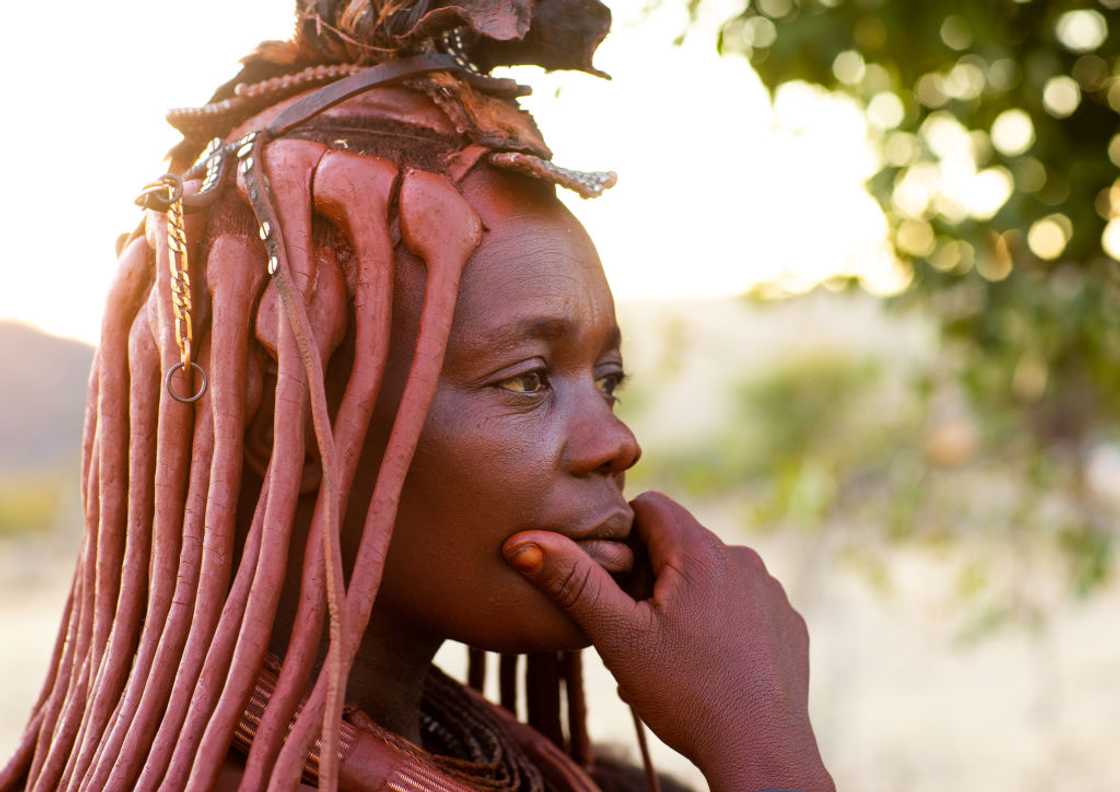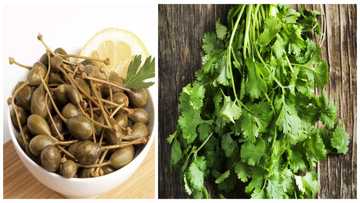The Himba tribe of Namibia: 10 interesting facts about the Himba people
The Himba tribe of Namibia, like other African tribes, has a unique culture that they inherited from their ancestors. Even though some aspects of their culture are similar to those of other world tribes, they also have cultural elements not practised by other tribes. However, due to the challenges posed by modernism, some of the cultural practices are slowly fading away.

Source: Getty Images
Kunene Region (formerly known as Kaokoland) in Namibia is the home of the Himba tribe. The OvaHimba are largely semi-nomadic pastoralists who own base homesteads where they plant crops and move from place to place in search of water.
Women remain at home to tend to domestic chores such as milking cows and raising their children while the men spend most of their time hunting. Their way of life has fascinated people from other parts of the world, which is why they have been featured in several studies and documentaries.
10 interesting facts of the Himba tribe
What are the Himba known for? As the last semi-nomadic herder community of Namibia, the culture of the Himba people has been the subject of international interest by people keen on learning about the heritage and preserving it. Some of the standout facts about this beautiful culture include:
1. The OvaHimba do not bathe
Since they live in a desert, water is a scarce resource, and as a result, the OvaHimba people do not bathe. Instead, when they want to clean their bodies, they use smoke. This is achieved by using herbs.
First, they put certain herbs and leaves in a small bowl and then put smoking charcoal into the bowl. They then put the bowl close to their bodies so that the heat and smoke can make them sweat.
The process is made more effective by covering the body and bowl using a blanket so that the smoke and heat does not escape. When the body starts sweating, they move from the smoke and let their bodies wash in the sweat.
Smoke bathe helps not only for cleaning but also acts as medicine. When it comes to their hair, they rely on wood ash as a cleansing agent. This happens to be among the unique Himba tribe customs that cannot be found anywhere else.
2. The Himba worship Mukuru
OvaHimba are deeply religious, and their god is known as Mukuru. They believe that their god is busy in a distant realm, and for that reason, they have to reach their ancestors as Mukuru's representatives.
Their homes are usually built to surround an ancestral fire (okuruwo) and their livestock. These two things are central to their belief in ancestor worship. Okuruwo represents ancestral protection, while cows signify proper relations between the people and their ancestors.
Each family must have its traditional fire under the guardianship of a fire-keeper who attends to it every seven to eight days. This acts as the channel through which he communicates with Mukuru and the ancestors on behalf of the family.
3. They have unique hairstyles for men and women

Source: Getty Images
One of the distinctive features of the Himba people is their hair. The Himba tribe hair is not just a beauty symbol. They have different hairstyles, and all have different meanings. For instance, hairstyles can be used to indicate differences in age and social class.
Typically, young girls have two plaits of braided hair locally known as ozondato. The form of the plaits is determined by the patrilineal descent group to which a girl belongs. As they reach puberty, the girls adorn long plaits that hang loose around the head. They can also take various forms. For example, some girls prefer to wear wigs over the plaits.
After the puberty ceremony, the girls receive headdresses known as ekori, made from tanned sheep or goatskin. The ekori has three leaf-shaped points that are decorated with iron beads.
Some girls prefer having their heads shaved, and only a tiny patch of hair is left at the top of the hair. The shaved hair is reused as plaits woven into the remaining patch and left to hang down the face.
The ekori headdress is worn until a girl has been married for about a year or gives birth to a child. After the Himba tribe marriage, it is replaced with erembe. Erembe is a kind of headdress made from the skin of a goat’s head. The girl retains the ekori but only to be worn during ceremonies.
OvaHimba men also have a variety of hairstyles. For instance, young boys usually wear the single plait known as Ondato. The braid runs down the back of the head.
On the other hand, men who have attained the age when they can marry adorn ozondato, a double-plait hairstyle. They also wear ombwiya, which is a headdress made from fabric and decorated with an ornamental band.
4. The Himba jewellery represent ancient customs
Nowadays, people buy jewellery just because they look beautiful without having any cultural attachment to them. Even though the jewellery adorned by OvaHimba contribute to external aesthetics, they usually have a deeper meaning. In most cases, their jewellery is adorned based on ancient customs.
It is typical for both men and women to wear many necklaces and arm bracelets, some of which go the entire extent of their arms. The bracelets are made from copper, grass, ostrich eggshell beads and cloth. The bracelets can weigh up to 40 kg.
They also wear iron oxide powder because of its shiny effect. The beaded anklets worn by women help to protect them from the bites of venomous animals.
5. They use red ochre to protect their skins from the sun
One of the most distinguishing features of the Himba people is their red skin. However, their skins are not red. The Himba tribe colour experiment shows that the appearance is due to a mixture containing red ochre, butter, and fat.
Red ochre is a type of stone (Hematite) which they pound until it is fine. The fragments are then mixed with butter, and then the mixture is slightly heated using smoke.
The red ochre is applied only by women. As a result, it serves to establish the difference between men and women in the community. That is not the only function of the ochre, as it is believed that the layer protects against the scorching sun of the desert. It retains moisture which cools the skin and keeps it clean. Another function it has is to slow down the growth of hair on the skin.
6. OvaHimba offer sex to guests

Source: Getty Images
It is a common practice of the Himba people to offer their guests sex. This practice is known as "okujepisa omakazendu", which translates to "offering wife to guest". A man will allow his wife to sleep with his guest for the night to show that the guest is valued and welcome.
When a Himba man offers a guest his wife for the night, he is mandated to leave the hut for them and sleep elsewhere. If he cannot find another house to accommodate him for the night, he will have to sleep outside. This reduces jealousy and fosters warm relationships.
7. The Himba originated from Angola
The Himba tribe location has not always been in Namibia. They are said to have come from Angola in the 1500s and finally settled in the Kunene region. Initially, the people now known as Himba belonged to a tribe known as Herero. However, the Herero tribe was hit by a massive shortage of cows forcing it to split into different tribes.
While most people moved south to look for land where their remaining cows would survive, some opted to stay, hoping that better days were ahead. Those who remained were given the name Himba which means beggar. They had to roam around neighbouring villages asking other tribes to help with cattle and crops when they were left behind.
8. They never go a day without porridge
Porridge is one thing OvaHimba can never finish a day without taking is porridge. So they take porridge at least twice a day in the morning and evening. The porridge is prepared by heating water until it boils.
They then add flour (maize or millet) and oil at times. The mixture is then stirred until it is ready to serve. To them, meat is a rare treat eaten only during special occasions such as weddings.
9. Polygamy is a common practice among Himba people
Polygamy is a way of life among the OvaHimba. It is a patriarchal society explaining why the Himba tribe women tend to the homestead and do most hard labour chores. Since women are viewed as helpers meant to do tasks, a man can marry multiple women.
Most of the Himba women are married off at a young age. As soon as puberty starts, their fathers arrange to marry them off.
10. Their homesteads are built on the edge of the village
The houses of Himba are cone-shaped structures erected at the edge of the village. The places are made from mud, mopane trees and cow dung supported by a central kraal.
The main kraal gate leads into the chief's hut, and the people believe a sacred line connects them. The holy fire 'okuruwo' is located right at the centre of the village. The doors of all the huts must face away from the village.
The Himba tribe is among the few tribes caught in the struggle between conserving their ways and modernism. For instance, it may be standard practice for them not to bathe but outside communities; this may be viewed as primitive. There is also the quest for education, seeing their children leave the village to attend school in neighbouring towns.
Yen.com.gh shared an article on Aliko Dangote detailing the top 10 interesting facts about Africa's richest man. He has constantly and consecutively maintained his position as the richest man in Africa. The Nigerian mogul built himself a name of not only being a rich man but a philanthropist too.
Aliko Dangote is a Nigerian businessman and renowned philanthropist. He is Africa’s richest man with a real-time net worth of $8.7 billion as of April 2020. As a philanthropist, he is the Founder and President of Africa’s largest charity organisation, The Dangote Foundation, with an endowment of $1.25 billion.
Source: YEN.com.gh









